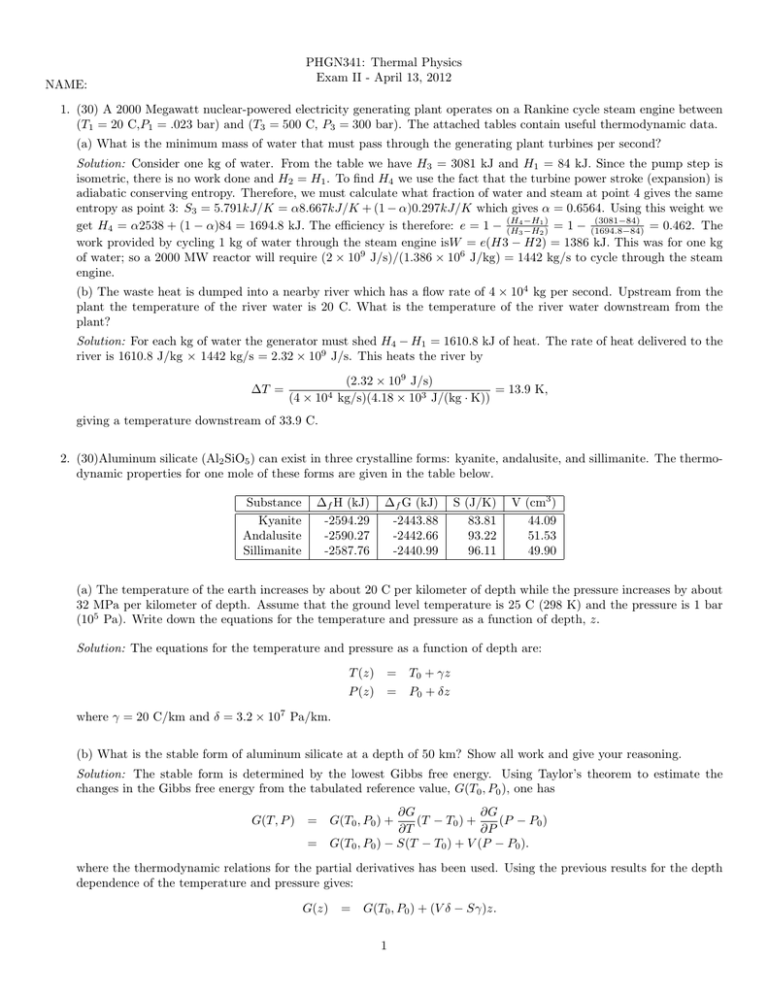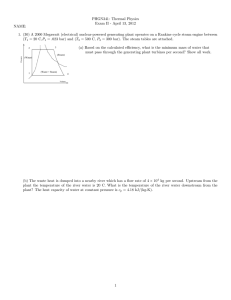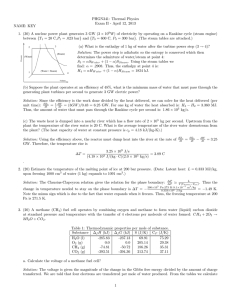PHGN341: Thermal Physics Exam II - April 13, 2012 NAME:
advertisement

PHGN341: Thermal Physics
Exam II - April 13, 2012
NAME:
1. (30) A 2000 Megawatt nuclear-powered electricity generating plant operates on a Rankine cycle steam engine between
(T1 = 20 C,P1 = .023 bar) and (T3 = 500 C, P3 = 300 bar). The attached tables contain useful thermodynamic data.
(a) What is the minimum mass of water that must pass through the generating plant turbines per second?
Solution: Consider one kg of water. From the table we have H3 = 3081 kJ and H1 = 84 kJ. Since the pump step is
isometric, there is no work done and H2 = H1 . To find H4 we use the fact that the turbine power stroke (expansion) is
adiabatic conserving entropy. Therefore, we must calculate what fraction of water and steam at point 4 gives the same
entropy as point 3: S3 = 5.791kJ/K = α8.667kJ/K + (1 − α)0.297kJ/K which gives α = 0.6564. Using this weight we
(3081−84)
4 −H1 )
get H4 = α2538 + (1 − α)84 = 1694.8 kJ. The efficiency is therefore: e = 1 − (H
(H3 −H2 ) = 1 − (1694.8−84) = 0.462. The
work provided by cycling 1 kg of water through the steam engine isW = e(H3 − H2) = 1386 kJ. This was for one kg
of water; so a 2000 MW reactor will require (2 × 109 J/s)/(1.386 × 106 J/kg) = 1442 kg/s to cycle through the steam
engine.
(b) The waste heat is dumped into a nearby river which has a flow rate of 4 × 104 kg per second. Upstream from the
plant the temperature of the river water is 20 C. What is the temperature of the river water downstream from the
plant?
Solution: For each kg of water the generator must shed H4 − H1 = 1610.8 kJ of heat. The rate of heat delivered to the
river is 1610.8 J/kg × 1442 kg/s = 2.32 × 109 J/s. This heats the river by
∆T =
(2.32 × 109 J/s)
= 13.9 K,
(4 × 104 kg/s)(4.18 × 103 J/(kg · K))
giving a temperature downstream of 33.9 C.
2. (30)Aluminum silicate (Al2 SiO5 ) can exist in three crystalline forms: kyanite, andalusite, and sillimanite. The thermodynamic properties for one mole of these forms are given in the table below.
Substance
Kyanite
Andalusite
Sillimanite
∆f H (kJ)
-2594.29
-2590.27
-2587.76
∆f G (kJ)
-2443.88
-2442.66
-2440.99
S (J/K)
83.81
93.22
96.11
V (cm3 )
44.09
51.53
49.90
(a) The temperature of the earth increases by about 20 C per kilometer of depth while the pressure increases by about
32 MPa per kilometer of depth. Assume that the ground level temperature is 25 C (298 K) and the pressure is 1 bar
(105 Pa). Write down the equations for the temperature and pressure as a function of depth, z.
Solution: The equations for the temperature and pressure as a function of depth are:
T (z)
P (z)
= T0 + γz
= P0 + δz
where γ = 20 C/km and δ = 3.2 × 107 Pa/km.
(b) What is the stable form of aluminum silicate at a depth of 50 km? Show all work and give your reasoning.
Solution: The stable form is determined by the lowest Gibbs free energy. Using Taylor’s theorem to estimate the
changes in the Gibbs free energy from the tabulated reference value, G(T0 , P0 ), one has
G(T, P )
∂G
∂G
(T − T0 ) +
(P − P0 )
∂T
∂P
= G(T0 , P0 ) − S(T − T0 ) + V (P − P0 ).
= G(T0 , P0 ) +
where the thermodynamic relations for the partial derivatives has been used. Using the previous results for the depth
dependence of the temperature and pressure gives:
G(z)
= G(T0 , P0 ) + (V δ − Sγ)z.
1
Applying this to the three forms of aluminum silicate gives:
Gkyan (z) = −2.44388M J − (2.653 × 102 J/km)z → −2.45715M J at z = 50km
Gandal (z) = −2.44266M J − (2.154 × 102 J/km)z → −2.45343M J at z = 50km
Gsilli (z) = −2.44099M J − (3.254 × 102 J/km)z → −2.45726M J at z = 50km
From these values we conclude that Sillimantite will be the stable form at a depth of 50 km. Note that since the
magnitude of the slope of the Gibbs free energy as a function of z for Andalusite is less than that of Kyanite, Andalusite
will not be the stable form at any depth.
3. (40)(a) Consider an ideal gas consisting of N indistinguishable (massless) neutrinos at temperature, T . Recall the
particle-in-a-box result for the density of states in momentum space: d3 n = hV3 d3 p. Use this to calculateRthe partition
function for a single neutrino by integrating the Boltzmann factor times the density of states, i.e. Z =
d3 n e−βEp ,
where the kinetic energy is given by the ultrarelativistic relation: Ep = pc where c is the speed of light.
Solution: (In this problem we ignore the spin-1/2 (Pauli exclusion) nature of the neutrinos.) Performing the indicated
integral gives the partition function for one neutrino:
Z
Z ∞
V
V
3
−βcp
d
p
e
=
4π
dp p2 e−βcp
Z1 =
h3
h3
0
Z ∞
8πV
4πV
dx x2 e−x = 3 3 3 .
=
3
3
3
h β c 0
h β c
(b) Calculate the average energy of one neutrino. Comment on your result.
Solution: The average energy is given by
Ē
= −
∂
∂
3
log Z1 = −
[−3 log β + log{other stuff}] = = 3kT.
∂β
∂β
β
This is twice what is expected from the equipartition theorem. This is due to the fact that the energy for the ultrarelativistic neutrino is linear in the momentum, not quadratic.
(c) What is the partition function for the N-neutrino gas? (Use the Sterling’s approximation result, N ! ' N N e−N .)
Solution: The partition function for the N-neutrino gas is
Z1N
ZN
' N 1 −N
N!
N e
where we divide by N ! to account for the fact that the neutrinos are indistinguishable.
Z
=
(d) From the Helmholtz free energy, F = −kT ln Z, calculate the pressure for the neutrino gas. Comment on your
result.
Solution: The Helmholtz free energy for the N-neutrino gas is
Z1N
Z1
F = −kT log
= −N kT log
+1
N N e−N
N
8πV
= −N kT log
+1 .
N h3 β 3 c3
The pressure is therefore:
∂Z
N kT
=
.
∂V
V
which is the standard ideal gas law. This is expected since the pressure arises from the momentum change at the
bounding surface, not the energy.
P
= −
2





